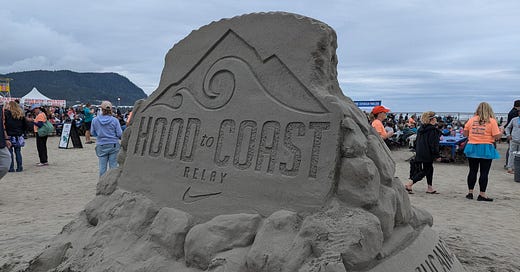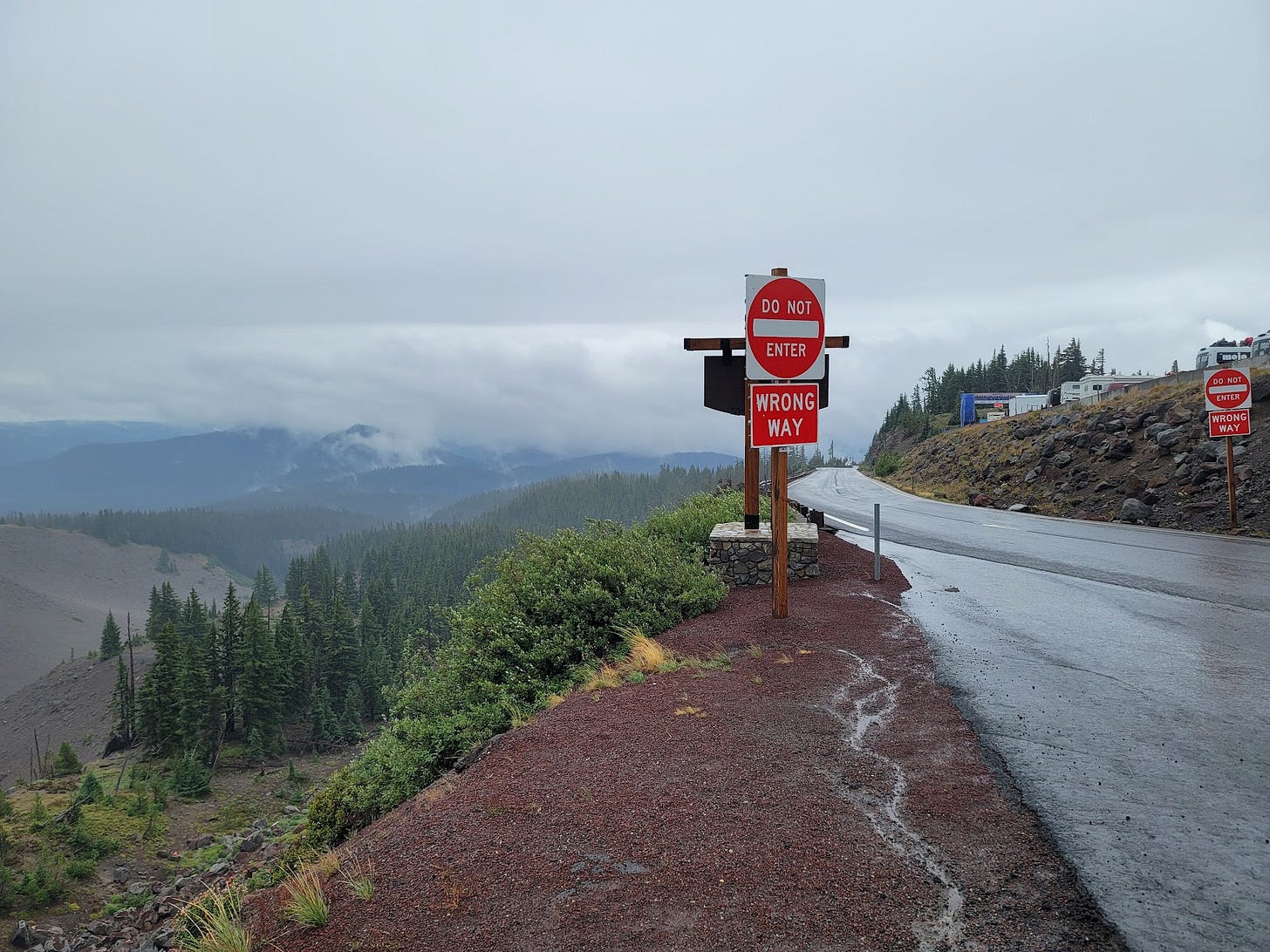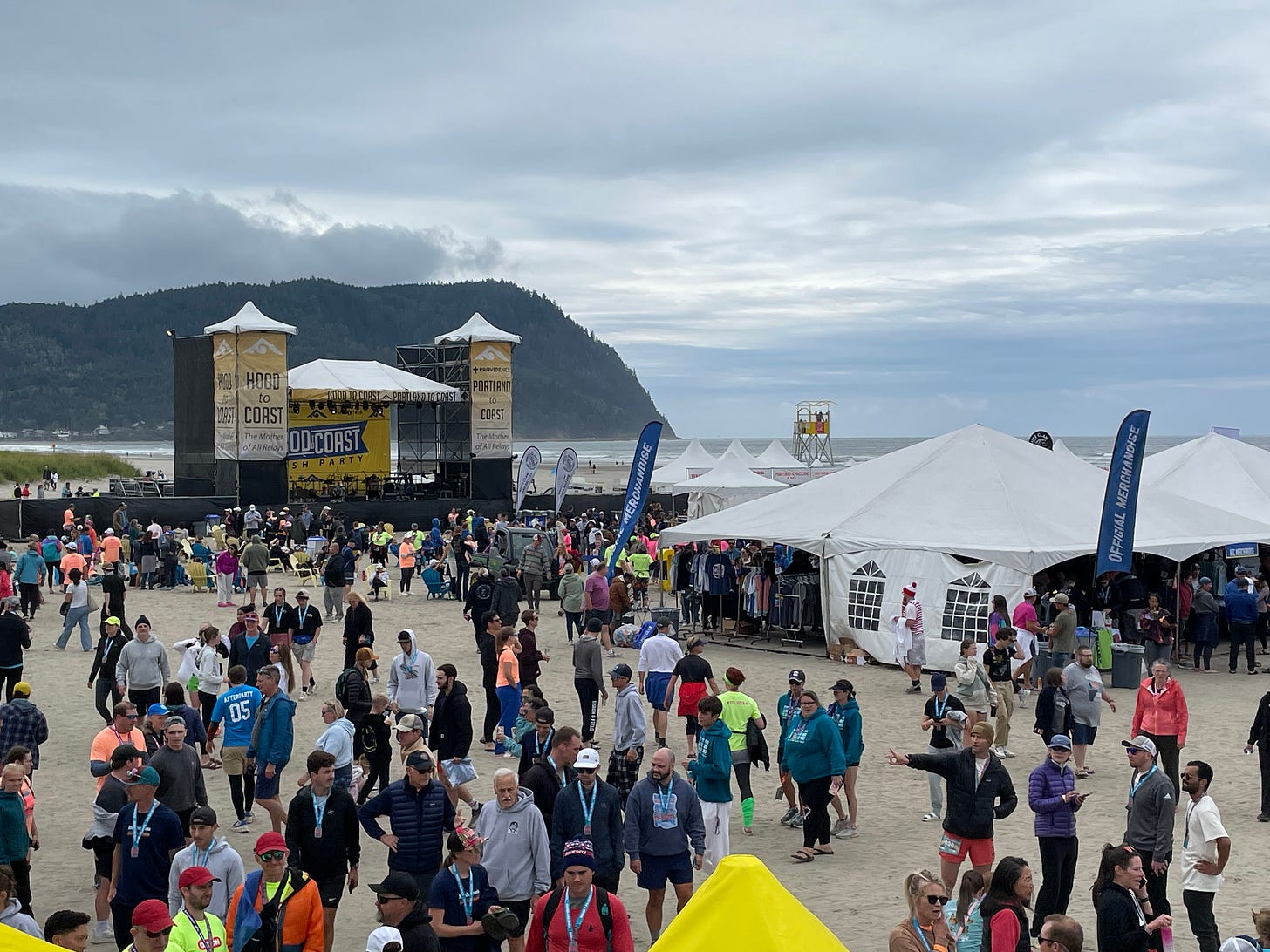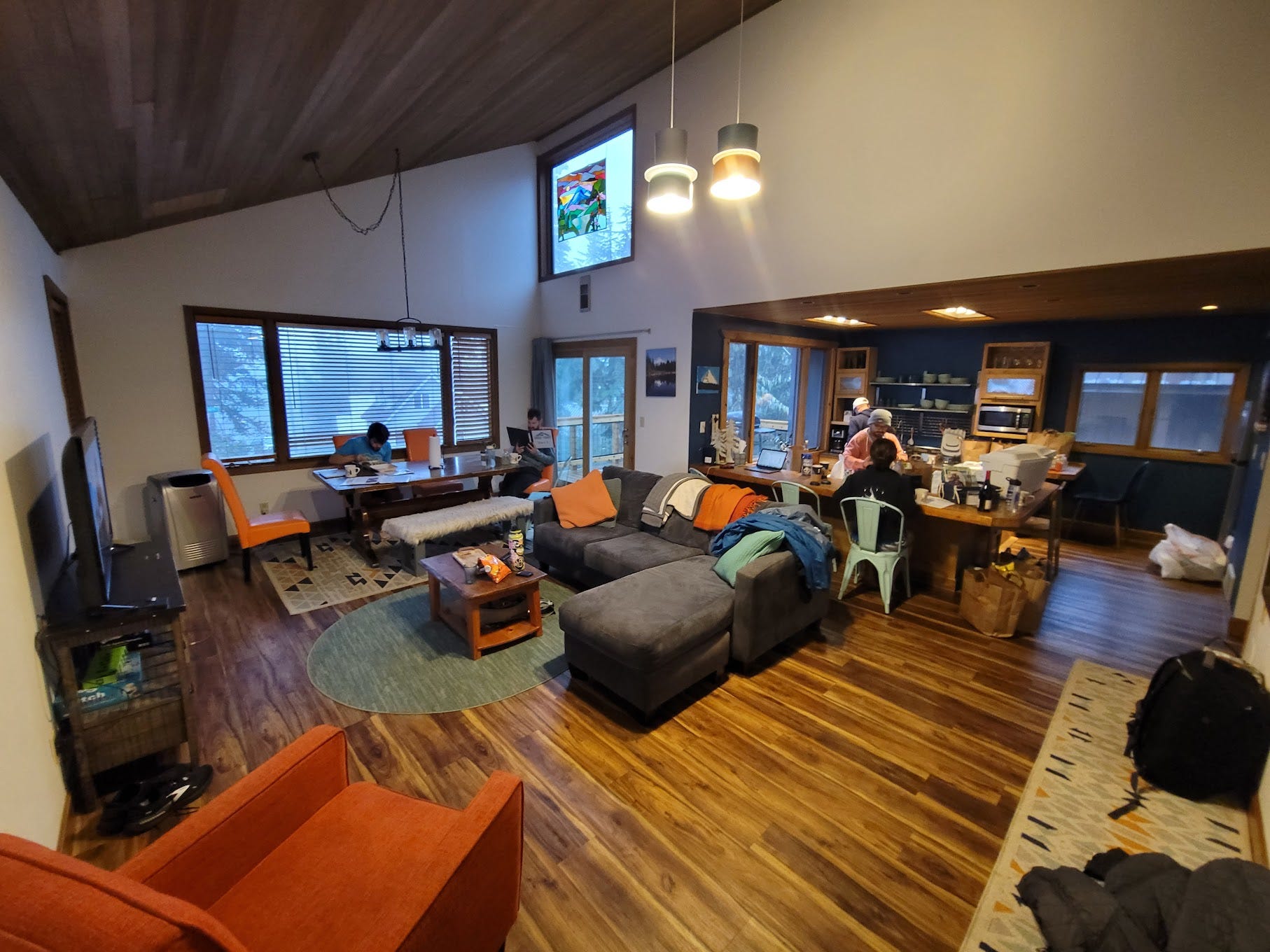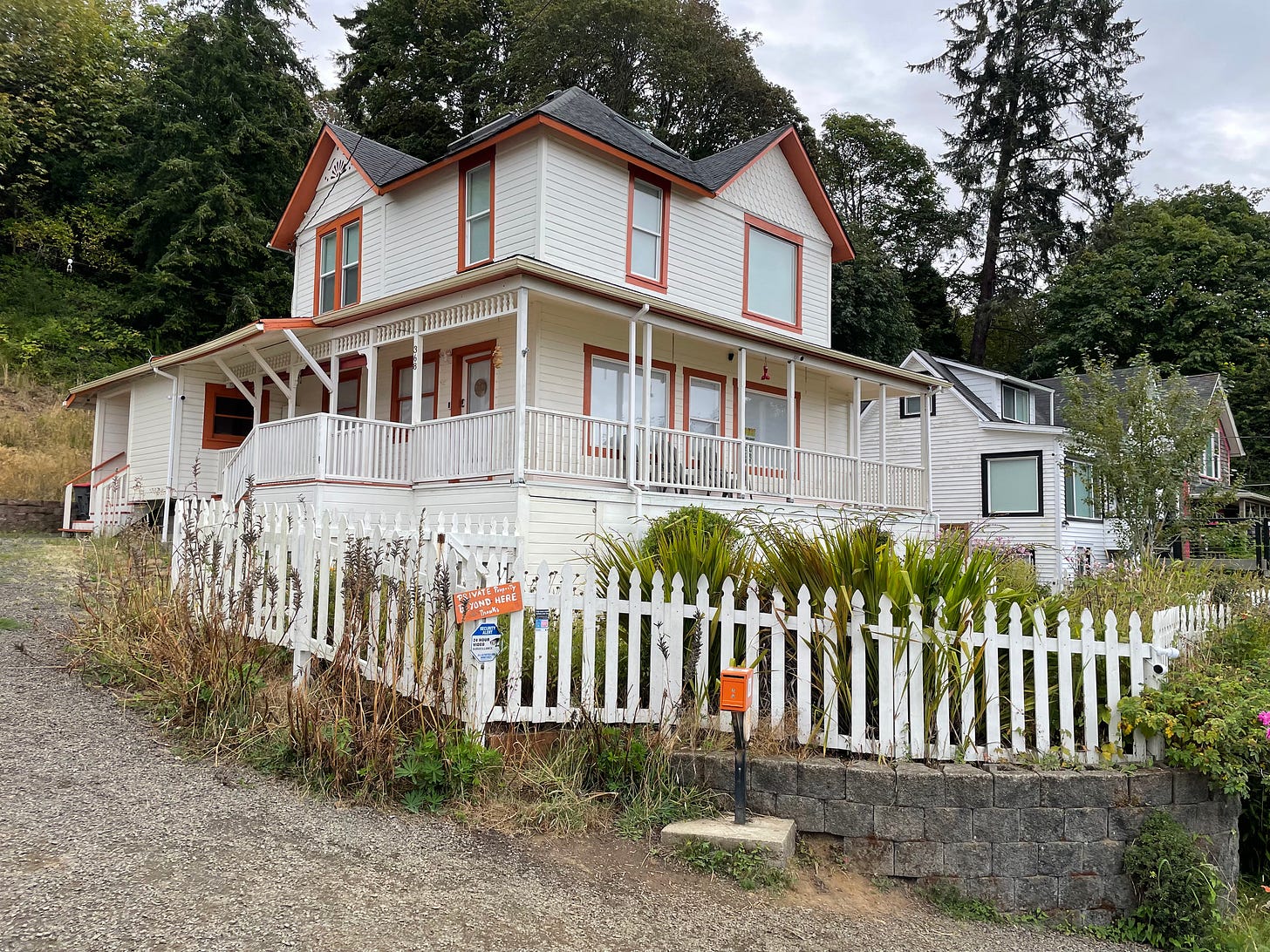I glance sideways and down at my watch. It’s just after nine-thirty on a soggy Friday night, and I’m running along the debris-strewn shoulder of US 30 northwest of Portland. US 30 is a historic four-lane artery that winds through the lush landscape of the Pacific Northwest, along the Columbia River Gorge. It was built in the early 20th century over sections of the Oregon Trail. Once a bustling route for fur traders, loggers, and pioneers, US 30 is now a modern highway, carrying freight and people and the echoes of countless journeys—each mile steeped in stories of personal ambition, exploration, and the relentless push against the elements.
The Columbia River flows to my right under a shroud of gloomy late summer darkness; I can’t see it—heck, I can’t see anything beyond the small halo of my LED headlamp—but I can sense it. Log trucks and tankers whiz past my left elbow before disappearing into the night, belting out a steady rhythm punctuated by blasts of diesel and the wet, rollicking sound of tires on the highway.
The rain picks up. So does the incline. What am I doing here on the side of a highway in Oregon? Just ahead, I can see the flashing safety lights of other runners on the course. I pass someone, we exchange the breathy “good jobs” that are like currency in the running community. Cresting the hill, I begin a blessed but too-short descent. And then, just as the next big hill comes into view, it occurs to me that I am totally alone. No more lights in front of me. No one behind me either. Hard to believe that a couple of hours ago, at the Leg 12 exchange, I stood in a sunny parking lot in downtown Portland, jaw-jacking with the team and taking in the festival atmosphere of the 42nd annual Hood to Coast Relay—affectionately known as the mother of all relays. Now I’m alone with the darkness. And my thoughts. With at least five miles to go before the next exchange, I make a solemn vow not to look at my watch for as long as I can stand it.

***
Run continuously since 1982, the annual Hood to Coast Relay is more than just the world’s most popular relay race; it’s an exhilarating festival of pain and bad food, all set against the rural majesty of the Pacific Northwest. It is also an exercise in community building. Imagine a grueling, 196-mile journey that commences on the slopes of Mount Hood, with its snow-capped peaks, before winding through verdant forests, picturesque towns and villages, downtown Portland, and finally, the shores of the Oregon coast.
Hood to Coast is immensely popular. Among the 12,000 or so runners who finished this year’s Hood to Coast, forty countries and all fifty states were represented. Even some celebrities, like Kevin Hart, make the journey to northwest Oregon. (Hart ran the relay in 2016.) The official course record of 15:44:55 was set in 1995 by Team Nike Mambu Baddu. To put this accomplishment in perspective, our team, Comin’ in HOT, finished in 25:44:38, or about ten hours longer than the course record, with an average mile split of 7:52 min / mile. We finished 119th out of 1181 teams overall.
Teams of intrepid runners, some dressed in outrageous gear or loaded up with hilarious signage, and bound by both a spirit of adventure and a higher-than-normal tolerance for pain, take on the challenge in a relay format, tackling various legs of the 36-leg course around the clock. The slowest teams set out from Mt. Hood on Friday morning at 3:00am sharp, but everyone must reach the finish—on the beach at Seaside—no later than 9:00pm Saturday night. Each participant experiences the thrill of running, whether sprinting through the twilight or navigating the darkness under a blanket of stars, with only the rhythmic pounding of feet or the distant sound of waves crashing in their ears.
HTC isn’t just about speed or even finishing; it’s about the collective journey, the bonding, the joy of passing the baton (or slap bracelet) from one team member to the next, and the heart-pounding excitement that comes with each exchange. Some of the exchanges were like tailgate parties or traveling carnivals; others, like the one I started out from Friday night, reminded me of the Do Lung bridge scene from Apocalypse Now: loud, chaotic, and to be honest, a little scary. Traffic can be hazardous, but I was surprised—and heartened—to find that there have been few fatalities in the 42 years that HTC has been run. One man died of a heart attack on the course in 2000, but I wasn’t able to find any information online about traffic-related fatalities or injuries.
I was lucky, in a way, because my first leg began at around 11:15am on Friday, which was the first day of the race. (As mentioned, some teams have to start as early as 3:00am on Friday morning; the slower the team, the ungodlier the hour of the start time.) We spent the previous night in a well appointed AirBnB chalet in Government Camp, so with a solid night’s sleep under my belt and about a gallon of strong black coffee coursing through my veins, by the time it got to be late morning I was chomping at the bit. Leg 3 had a slightly more gradual drop than Leg 1, but still with over 2,000 feet of downhill elevation, so it felt less like running and more like gliding. The only thing that slowed me down was the fear of slipping on the mud or slick pavement. In northwest Oregon, everything is covered in a permanent dampness. I tried to put it out of my mind and, for the most part, just let gravity carry me down the side of Mt. Hood.
The Hood to Coast route, as the name implies, begins on the top of Mount Hood, just outside Government Camp, Oregon, and hurtles down the mountain negotiating park service access roads, off-road trails, and a highway. There’s over 2,000 feet of elevation drop in Leg 1. A real quadbuster. Legs 2 and 3 combine for more than 2,300 feet of drop. Ian graciously volunteered for the first leg and turned it into a PR (personal record) in the 5K, finishing in around 18 and a half minutes flat.
My first leg of the race was Leg 3, a more gradual downhill 4.65-mile route that took advantage of a 3.5-mile trail section through heavy forest. Here’s Todd finishing Leg 2 and handing off the slap bracelet mid-slap.
As teams make their way towards the coast, they encounter challenging terrain and weather, but there’s quite a bit more to it than that. The logistics of the relay provide yet another layer of difficulty. Each 12-person team is composed of two vans: Van 1 and Van 2. Since the HTC is a relay, the vans follow the runners so that by the time the runner completes a leg and arrives at the next exchange, ideally, the appropriate van is there waiting for them with the next runner ready to fly. I don’t need to tell you this doesn’t always go smoothly. At nearly every exchange where I was waiting to run the next leg, there were at least a couple of runners who had been waiting on their teammate to arrive for five, ten, even fifteen minutes or longer. To make things more difficult, most of the race is run through rural, mountainous areas in northwestern Oregon, so the roads can only accommodate so many vans and vehicles; add to this the fact that there are, at any given time, thousands of runners on the roads and you have yourself what some might describe as a logistical nightmare in the making.
But hardship breeds community. The soul of a community—even an ad hoc one that lasts a short weekend—is forged in adversity. From the sheer determination on each runner’s face to the breathtaking views of the Columbia River Gorge, the Hood to Coast Relay transforms a mere road race into a tapestry of human connection. Case in point: a few days after I returned home, I was running near Butler, when a shirtless young guy coming towards me on the towpath saw my race t-shirt and started screaming “I was there! I was there!” If you finish the HTC, you want people to know about it.
Just before 5:00am on Saturday morning, I started my third and final leg of the relay.(Each runner on a 12-person team runs three legs.) I didn’t get much “sleep” the night before; just a couple hours on the floor of the van that occurred sometime between 2:00 and 4:00am that morning. It was pitch dark when I started, but by the end of my six-miler near Jewell Meadows, a weak sunlight peeked through the fir trees lining the roadway. At nearly every mile on my final leg was a sign for Jewell Camp up ahead: “Showers. Sleep. Food. X miles ahead.” The good vibes I got from just seeing that sign played an outsized role in getting me to the finish of that last leg.
Later that morning, all the runners in my van (Van 1) finished their legs of the race, so we had a few hours of free time before heading to the sandy beaches of Seaside and the ultimate reward—an epic beach party on Saturday afternoon where aching muscles give way to laughter, high-fives, and the shared triumph of having conquered one of the most iconic relays in the world.
The overall winners, a team called Government Cheese, finished the 196-mile route in 17 hours and 48 minutes with an average mile split of 5:27 minutes per mile. An impressive time, to be sure, but still two hours slower than the course record set back in 1995. Keep in mind, too, that this is not a road race (which makes that sub-5:30 split time that much more impressive!), but a mixed terrain relay that traverses different climate zones and ecoregions, from the West Cascades to the Willamette Valley and beyond to the Coast Range and the Pacific Ocean.
***
As it happens, coastal Oregon really does look like the set from The Goonies.
How do I know this? Because on Saturday morning, after Van 1 finished up our final legs and happily turned the rest of the relay over to our teammates in Van 2, we drove up to Astoria to see it. The house from the film The Goonies is a charming, weathered two-story home perched on a hillside overlooking a quiet coastal town. Its exterior is adorned with a white, wooden clapboard siding that has seen years of salty sea air, giving it a rustic, slightly worn look. The front porch, framed by a picket fence, offers a panoramic view of the ocean, with a clear sense of history and adventure embedded in its walls.
Sunday morning, after sleeping for twelve hours in what may well be the cleanest—and most expensive—Motel 6 in North America ($407.00 per night, the high cost of staying within a half-mile of the HTC finish line), we got up and walked to the beach. The sun was brilliant, and it was already nearly 70 degrees. Though we hobbled and wobbled like geriatrics on painkillers, everybody was riding the high from the previous 33 hours. What will next year hold? Will we do it again?
I hope so. But for now, I am glad to be back on flat land and to have this event behind me for another year. The human body only produces so much adrenaline after all, and I need to replenish my stores.
Thanks for reading!
Special thanks to Tracy Snider for setting all this up and inviting me to tag along. Thanks also to Todd Oliver for driving and holding the crew together. And thanks to all my teammates for a terrific weekend and lasting memories.

